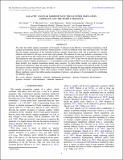GALACTIC ANGULAR MOMENTUM IN THE ILLUSTRIS SIMULATION: FEEDBACK AND THE HUBBLE SEQUENCE
Author(s)
Genel, Shy; Fall, S. Michael; Hernquist, Lars; Vogelsberger, Mark; Snyder, Gregory F.; Rodriguez-Gomez, Vicente; Sijacki, Debora; Springel, Volker; ... Show more Show less
DownloadGenel-2015-GALACTIC ANGULAR MOM.pdf (681.5Kb)
PUBLISHER_POLICY
Publisher Policy
Article is made available in accordance with the publisher's policy and may be subject to US copyright law. Please refer to the publisher's site for terms of use.
Terms of use
Metadata
Show full item recordAbstract
We study the stellar angular momentum of thousands of galaxies in the Illustris cosmological simulation, which captures gravitational and gas dynamics within galaxies, as well as feedback from stars and black holes. We find that the angular momentum of the simulated galaxies matches observations well, and in particular two distinct relations are found for late-type versus early-type galaxies. The relation for late-type galaxies corresponds to the value expected from full conservation of the specific angular momentum generated by cosmological tidal torques. The relation for early-type galaxies corresponds to retention of only ~30% of that, but we find that those early-type galaxies with low angular momentum at z = 0 nevertheless reside at high redshift on the late-type relation. Some of them abruptly lose angular momentum during major mergers. To gain further insight, we explore the scaling relations in simulations where the galaxy formation physics is modified with respect to the fiducial model. We find that galactic winds with high mass-loading factors are essential for obtaining the high angular momentum relation typical for late-type galaxies, while active galactic nucleus feedback largely operates in the opposite direction. Hence, feedback controls the stellar angular momentum of galaxies, and appears to be instrumental for establishing the Hubble sequence.
Date issued
2015-05Department
Massachusetts Institute of Technology. Department of Physics; MIT Kavli Institute for Astrophysics and Space ResearchJournal
The Astrophysical Journal. Letters
Publisher
IOP Publishing
Citation
Genel, Shy, S. Michael Fall, Lars Hernquist, Mark Vogelsberger, Gregory F. Snyder, Vicente Rodriguez-Gomez, Debora Sijacki, and Volker Springel. “GALACTIC ANGULAR MOMENTUM IN THE ILLUSTRIS SIMULATION: FEEDBACK AND THE HUBBLE SEQUENCE.” The Astrophysical Journal 804, no. 2 (May 10, 2015): L40. © 2015 The American Astronomical Society
Version: Final published version
ISSN
2041-8213
2041-8205